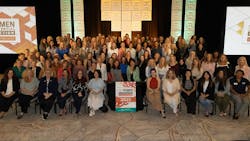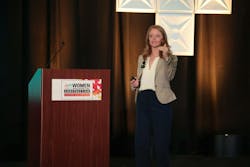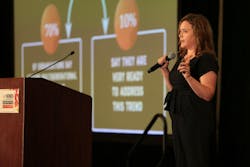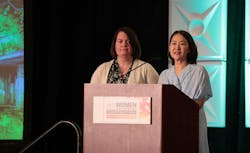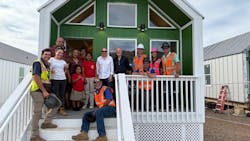6 WIRC Conference Insights That'll Change How You Work
Key Highlights
-
Women in construction are now 11.2% of the workforce, the highest in 20 years, and are offering fresh perspectives to the field.
- Speakers at our Women in Residential Construction Conference put a spotlight on key issues holding builders and residential designers back.
-
From operational efficiency to untapped market opportunities, there are six key takeaways you can act on today.
Women now represent 11.2% of the construction workforce, the highest share in two decades, and the 2025 Women In Residential Construction (WIRC) Conference—a collaboration between Custom Builder, Pro Builder, and Pro Remodeler—proved why that matters.
The speakers brought fresh perspectives on everything from operational efficiency to market opportunities that too many builders are overlooking. Here are six takeaways from the WIRC Conference that will actually change how you work:
1. You're Wasting Time on Bad Workflows
Dr. Anna Hunter, director of learning and development at construction estimating and project management platform JobTread, gave us the keys to operational efficiency: most builders are drowning in unnecessary steps, redundant handoffs, and approval processes that add zero client value, she said.
Her solution is process mapping. Used by NASA and others with critical workflows, it's the practice of making every step visible, putting it down on paper, and then ruthlessly analyzing the process to understand what's essential, what's redundant, and what slows projects down.
“Until you get to the root of the issue, more staff, and more software and more money thrown at the problem isn’t going to solve it,” Dr. Hunter said. Add the people and software in later, she said, to help support a more effective workflow.
Do this now: Pick one workflow this week: lead generation, pre-construction, project closeout (whatever frustrates you most). Then map it out visually. Start with the big picture workflow, and then fill in small sub steps (she suggests noting people involved and any software used in each step).
And, then, put yourself in the mindset of your client, or a sub, or your team (that’s when you identify the right questions), and ask:
- Can steps be combined or run concurrently?
- Can anything be automated?
- Are there too many approval tiers?
- Are there too many handoffs (what if your first priority is someone else’s third?)?
- Were any steps added because something ‘bad’ happened once? (focus on better training over a permanent process step, she said)
And then invite your team into the conversation (you don't need all the answers). A single process map may take effort, but if you want your time back, you need to put something to paper to be able to solve it, she said. It can't just live in your head.
2. You're Not Framing Universal Design Right
Stop thinking of universal design as just for people with disabilities or for the elderly, said Sara Jorgensen, design team manager at Harrel Design + Build. The reality is that universal design is luxury planning that can appeal to a variety of clients: Baby Boomers aging in place, Millennials planning for multi-generational living, and anyone building a "forever home."
In kitchens, she suggested fold-away step stools, touchless faucets, microwave drawers, varied counter heights, and induction cooktops. In bathrooms, she called out roll-under vanities (storage space, for now), wall-hung toilets (so 'modern'), multiple light sources, and grab bars disguised as towel bars (they've come a long way).
Do this now: Clients may resist universal design because they think, "We don't need to worry about that now." But frame it as flexibility and luxury, not aging in place, and it becomes an easier sell, said Jorgensen.
Examples: a curbless shower (it's "spa-like," "easy to clean"), a pre-planned elevator shaft (a closet for now, as long as there are no mechanicals; it's "future-ready" and "preserves resale value"), or smart home controls (they offer "convenience and energy savings").
You're future-proofing their investment while creating a more comfortable home for everyone who lives there or visits, Jorgensen said.
3. You're Failing to Address Generational Friction
Generation Z now makes up 18% of the workforce, so you're likely dealing with a multi-generational team ... and the friction that frequently comes with it. Citing her own Gentelligence research, Dr. Megan Gerhardt, professor of management and leadership at Miami University, revealed why generational conflict is happening and challenged attendees to leverage differences between generations to increase engagement and organizational success.
The issue isn't that Gen Z is "distracted" or that Boomers "are out of touch," she said. Every generation shares the same core needs (respect, connection, competence, autonomy) but they just express them differently.
Example: Gen Z grew up with explanations for everything at their fingertips. So, when you enforce a rule without offering any context, it feels arbitrary and breeds distrust.
Do this now: Work to identify your assumptions or stereotypes about each generation. This might be as simple as noticing that you're assigning your younger workers more tech-enabled tasks. Then, try to adjust the lens by which you're viewing others' behaviors (is your Gen Z teammate rude because they're on their phone? Or are they taking notes, or looking up a resource to add to the conversation?). This process can help your team overcome some of those stereotypes, Dr. Gerhardt said.
Then, find ways to take advantage of the generational differences. Create intergenerational project teams and elicit regular feedback on how to work better together. You may have a mentoring program, where older colleagues teach younger ones, but do you have "reverse mentoring," where younger people teach their older peers new skills?
Then, finally, set some ground rules. Identify your organization's "load-bearing walls"—the non-negotiables in your culture (e.g., returning to the office certain days, maintaining job site safety protocols), and then explain why they matter. Don't assume younger employees understand the reasoning, and don't assume they don't deserve an explanation, Dr. Gerhardt said. Building trust through context pays off in retention and performance.
4. You're Holding Back from Using AI
There's an AI tool for just about everything, which can be overwhelming. But at the pace things are moving, builders who start testing now will gain the advantage. As the saying goes: You won’t be replaced by AI, but by someone who uses it.
Katy Reynolds, CEO and co-founder of Shibusa Systems called out the industry for its reluctance, saying that home building is the second oldest profession in the world, and the last to undergo a technological revolution.
She described how her firm is using AI for faster configuration of new housing models, automated site adaptation, and automated compliance with local building codes and zoning ordinances. The firm also uses "digital twins" (3D models informed by live data) for faster permitting, and as a home maintenance tool for residents and property managers.
Beyond Shibusa Systems' approach, we heard from the people behind three AI tools who showcased other ways AI is working its way into residential construction:
Code confusion. FORDJE clarifies code, permitting, and zoning requirements across 30,000+ U.S. municipalities. Instead of wading through thousands of pages of regulations yourself, the tool distills the code into actionable data, from site selection to final inspections. You can export results as a simple CSV file, pull them into Google Sheets, or connect directly via API. Note: Code confusion creates inefficiencies that account for more than 11% of development costs, according to NAHB research.
Land valuation. ARX uses AI to help you source and assess whether a site makes financial sense. The tool evaluates what's currently on the property, what can legally be built there, and site constraints like wetlands or topography that affect buildability. Co-founders Tomas and Hernan Garcia launched ARX in 2020, and were named a 2023 Ivory Innovations Prize top 25 finalist in finance.
Residential Design. Whereas ChatGPT and similar tools are trained on text data, the team behind Designi said their propreitary AI model was trained on architectural data, predominantly floor plans. The chatbot generates original floor plans from scratch (not copied from existing designs), and supports BIM and CAD in addition to other virtual or augmented reality formats. It produces multiple design options that meet project requirements, with cost estimates.
Do this now: Don’t wait for the “perfect” use case. Pick one area of your business (design, permitting, project management), and test a tool. The builders gaining an edge aren’t the ones waiting for AI to fully play out; they’re the ones experimenting with it now.
5. You're Missing the Wellness Real Estate Market
Katherine Johnson and Ophelia Yeung were on hand from the The Global Wellness Institute to let us know that the wellness real estate market is worth $239 billion in the U.S. and projected to hit $1 trillion by 2029—growing faster than overall construction.
The built environment is the next frontier and the greatest future opportunity for wellness, the team said. And it goes beyond physical wellness like saunas and spas, to include mental, social, civic, and environmental health parameters.
For home builders, this translates to clients who want homes that support holistic well-being: enhanced indoor air quality through HEPA filtration and low-VOC materials, circadian lighting systems that adjust throughout the day, biophilic design elements like natural materials and views of nature, soundproofing for mental health, and outdoor connections that encourage movement and reduce stress.
Do this now: Add a brief "Wellness Features" section to your next project proposal. Explain how specific choices, like window placement for natural light, or air quality systems you're specifying, support your clients' health. Stay on top of the wellness market (we have a lot planned on this front in 2026), and download the Global Wellness Institute's report here.
6. You're Not Prepared for Disaster, Or The Day After
Speakers from Pacific Palisades, Maui, and post-Katrina rebuilds shared a sobering reality:
Recovery and rebuilding take years. Laura Paul, executive director of Lowernine.org, which has been rebuilding homes in New Orleans' Lower 9th Ward since Katrina, explained that disaster recovery takes years, long after cameras leave and public attention fades.
Survivors are overlooked once immediate danger passes. The toxic FEMA trailers New Orleans residents faced after Katrina, however, were just a memory for the residents of Lahaina, on Maui, who were displaced by savage fires two years ago. That's thanks to Allysa Taylor and her team at Liv-Connected, who worked with FEMA to provide modular homes that provided survivors with a sense of dignity. To the question of why rebuild in vulnerable areas: because it's home, Taylor said.
Professional networks can prove critical. Lisa Copeland, CFO of KAA Design, explained how the Palisades Design Network formed quickly. A consortium of builders and architects, offering resources and support to rebuild and restore the Pacific Palisades and Altadena residential communities in Los Angeles, came together just days after the fires began because architects and builders already had working relationships. When disaster strikes, those existing connections allow communities to respond immediately rather than starting from scratch, Copeland said.
Do this now: If you work in a climate-vulnerable region, start building relationships with local architects, engineers, and contractors now, before disaster strikes. Attend municipal meetings, join regional building and design groups, and establish mutual referral networks. When your community faces a crisis, you'll be better positioned to help clients rebuild thoughtfully rather than scrambling to find qualified partners under pressure.
About the Author
Pauline Hammerbeck
Pauline Hammerbeck is the editor of Custom Builder, the leading business media brand for custom builders and their architectural and design partners. She also serves as a senior editor for Pro Builder, where she directs products coverage and the brand's MVP Product Awards. With experience across the built environment - in architecture, real estate, retail, and design - Pauline brings a broad perspective to her work. Reach her at [email protected].
